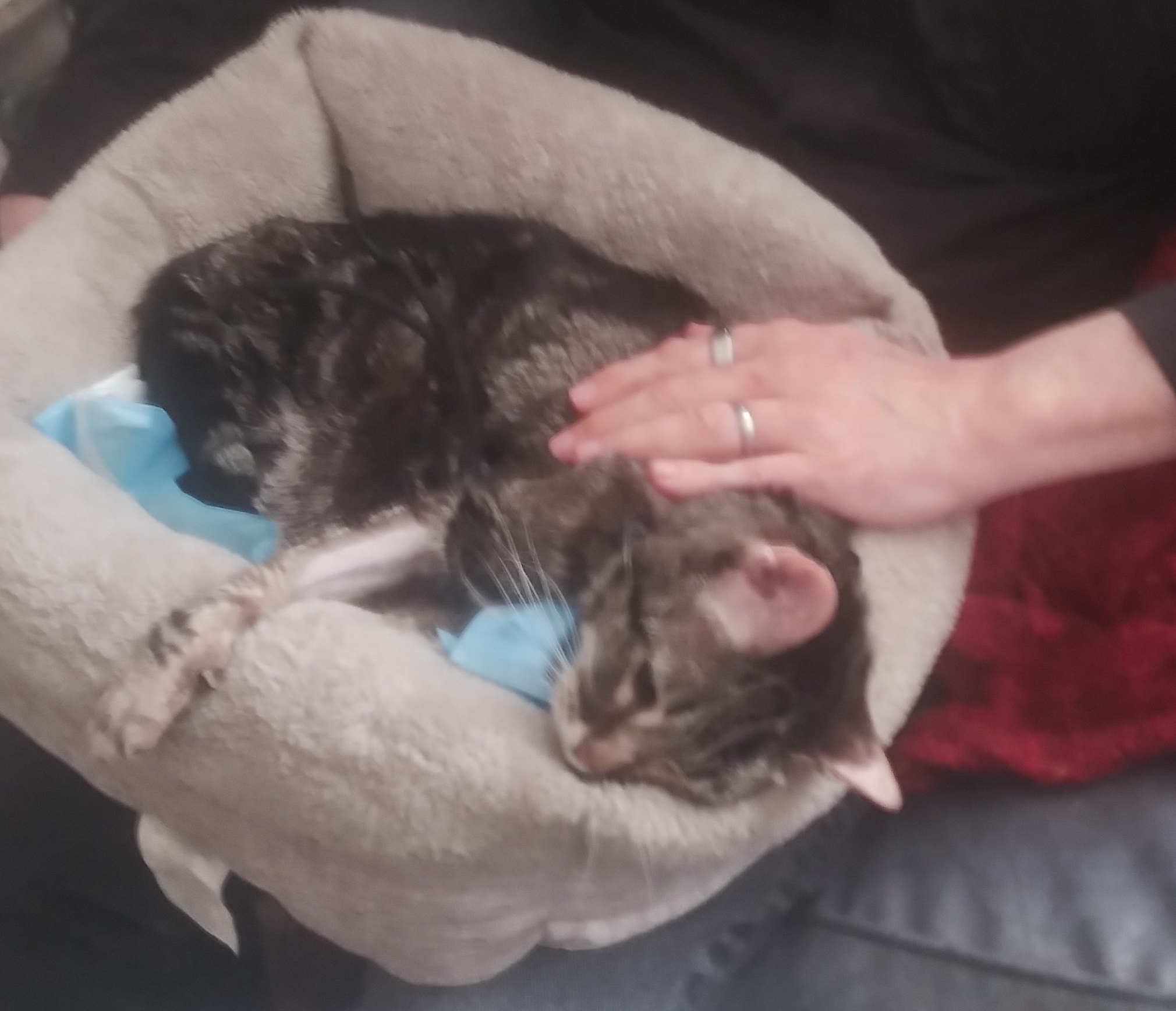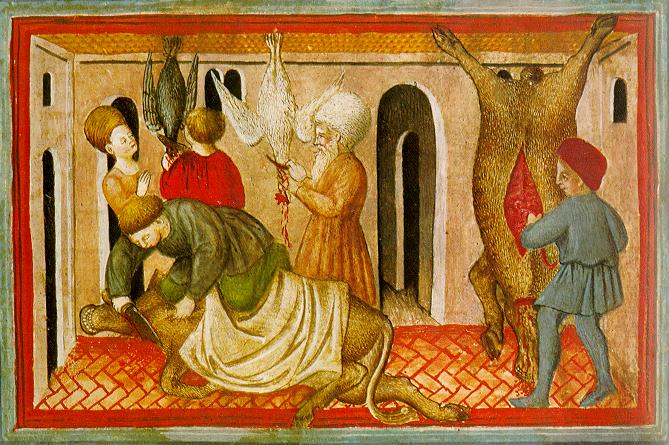|
Captive Bolt Pistol
A captive bolt pistol (also known as a captive bolt gun, a cattle gun, a stunbolt gun, a bolt gun, a stun gun and a stunner) is a device used for the stunning of animals prior to slaughter. A captive bolt pistol is intended to deliver a single, powerful strike to the forehead of an animal in order to quickly induce unconsciousness. Depending on the variation and usage, the bolt may or may not penetrate the skull and cause direct damage to the brain. The bolt consists of a heavy rod or piston, typically made of a corrosion-resistant material such as stainless steel. The bolt is actuated by a trigger pull and is propelled forward by either compressed air, a spring mechanism, or by the discharge of a blank round. After moving a short distance, spring tension causes the bolt to recoil back into the barrel. The captive bolt pistol was invented in 1903 by Hugo Heiss, the former director of a slaughterhouse in Straubing, Germany. Variations Captive bolt pistols are of three typ ... [...More Info...] [...Related Items...] OR: [Wikipedia] [Google] [Baidu] |
Cerebellum
The cerebellum (: cerebella or cerebellums; Latin for 'little brain') is a major feature of the hindbrain of all vertebrates. Although usually smaller than the cerebrum, in some animals such as the mormyrid fishes it may be as large as it or even larger. In humans, the cerebellum plays an important role in motor control and cognition, cognitive functions such as attention and language as well as emotion, emotional control such as regulating fear and pleasure responses, but its movement-related functions are the most solidly established. The human cerebellum does not initiate movement, but contributes to motor coordination, coordination, precision, and accurate timing: it receives input from sensory systems of the spinal cord and from other parts of the brain, and integrates these inputs to fine-tune motor activity. Cerebellar damage produces disorders in fine motor skill, fine movement, sense of balance, equilibrium, list of human positions, posture, and motor learning in humans. ... [...More Info...] [...Related Items...] OR: [Wikipedia] [Google] [Baidu] |
Veterinarian
A veterinarian (vet) or veterinary surgeon is a medical professional who practices veterinary medicine. They manage a wide range of health conditions and injuries in non-human animals. Along with this, veterinarians also play a role in animal reproduction, health management, Animal Conservation, conservation, husbandry and breeding and preventive medicine like animal nutrition, nutrition, vaccination and parasitic control as well as biosecurity and zoonotic disease surveillance and prevention. Description In many countries, the local nomenclature for a veterinarian is a regulated and protected term, meaning that members of the public without the prerequisite qualifications and/or license are not able to use the title. This title is selective in order to produce the most knowledgeable veterinarians that pass these qualifications. In many cases, the activities that may be undertaken by a veterinarian (such as treatment of illness or surgery in animals) are restricted only to thos ... [...More Info...] [...Related Items...] OR: [Wikipedia] [Google] [Baidu] |
Firearm
A firearm is any type of gun that uses an explosive charge and is designed to be readily carried and operated by an individual. The term is legally defined further in different countries (see legal definitions). The first firearms originated in 10th-century China, when bamboo tubes containing gunpowder and pellet projectiles were mounted on spears to make the portable fire lance, operable by a single person, which was later used effectively as a shock weapon in the siege of De'an in 1132. In the 13th century, fire lance barrels were replaced with metal tubes and transformed into the metal-barreled hand cannon. The technology gradually spread throughout Eurasia during the 14th century. Older firearms typically used black powder as a propellant, but modern firearms use smokeless powder or other explosive propellants. Most modern firearms (with the notable exception of smoothbore shotguns) have rifled barrels to impart spin to the projectile for improved flight stabili ... [...More Info...] [...Related Items...] OR: [Wikipedia] [Google] [Baidu] |
Powder-actuated Tool
A powder-actuated tool (PAT, often generically called a Hilti gun or a Ramset gun after their manufacturing companies) is a type of nail gun used in construction and manufacturing to join materials to hard substrates such as steel and concrete. Known as ''direct fastening'' or ''explosive fastening'', this technology is powered by a controlled explosion of a small chemical propellant charge, similar to the process that discharges a firearm. Features Powder-actuated tools are often used because of their speed of operation, compared to other processes such as drilling and then installing a threaded fastener. They can more easily be used in narrow or awkward locations, such as installing steel suspension clips into an overhead concrete ceiling. Powder-actuated tools are powered by small explosive cartridges, which are triggered when a firing pin strikes a primer, a sensitive explosive charge in the base of the cartridge. The primer ignites the main charge of powder, which bu ... [...More Info...] [...Related Items...] OR: [Wikipedia] [Google] [Baidu] |
Animal Euthanasia
Animal euthanasia (euthanasia from ; "good death") is the act of killing an animal humanely, most commonly with injectable drugs. Reasons for euthanasia include incurable (and especially painful) conditions or diseases, lack of resources to continue supporting the animal, or laboratory test procedures. Euthanasia methods are designed to cause minimal pain and distress. Euthanasia is distinct from animal slaughter and pest control. In domesticated animals, the discussion of animal euthanasia may be substituted with euphemisms, such as "put down" or "put to sleep" to make the wording less harsh. Methods The methods of euthanasia can be divided into pharmacological and physical methods. Acceptable pharmacological methods include injected drugs and gases that first depress the central nervous system and then cardiovascular activity. Acceptable physical methods must first cause rapid loss of consciousness by disrupting the central nervous system. The most common methods are discus ... [...More Info...] [...Related Items...] OR: [Wikipedia] [Google] [Baidu] |
Pharmaceutical
Medication (also called medicament, medicine, pharmaceutical drug, medicinal product, medicinal drug or simply drug) is a drug used to diagnose, cure, treat, or prevent disease. Drug therapy ( pharmacotherapy) is an important part of the medical field and relies on the science of pharmacology for continual advancement and on pharmacy for appropriate management. Drugs are classified in many ways. One of the key divisions is by level of control, which distinguishes prescription drugs (those that a pharmacist dispenses only on the medical prescription) from over-the-counter drugs (those that consumers can order for themselves). Medicines may be classified by mode of action, route of administration, biological system affected, or therapeutic effects. The World Health Organization keeps a list of essential medicines. Drug discovery and drug development are complex and expensive endeavors undertaken by pharmaceutical companies, academic scientists, and government ... [...More Info...] [...Related Items...] OR: [Wikipedia] [Google] [Baidu] |
European Union
The European Union (EU) is a supranational union, supranational political union, political and economic union of Member state of the European Union, member states that are Geography of the European Union, located primarily in Europe. The union has a total area of and an estimated population of over 449million as of 2024. The EU is often described as a ''sui generis'' political entity combining characteristics of both a federation and a confederation. Containing 5.5% of the world population in 2023, EU member states generated a nominal gross domestic product (GDP) of around €17.935 trillion in 2024, accounting for approximately one sixth of global economic output. Its cornerstone, the European Union Customs Union, Customs Union, paved the way to establishing European Single Market, an internal single market based on standardised European Union law, legal framework and legislation that applies in all member states in those matters, and only those matters, where the states ... [...More Info...] [...Related Items...] OR: [Wikipedia] [Google] [Baidu] |
Bovine Spongiform Encephalopathy
Bovine spongiform encephalopathy (BSE), commonly known as mad cow disease, is an incurable and always fatal neurodegenerative disease of cattle. Symptoms include abnormal behavior, trouble walking, and weight loss. Later in the course of the disease, the cow becomes unable to function normally. There is conflicting information about the time between infection and onset of symptoms. In 2002, the World Health Organization suggested it to be approximately four to five years. Time from onset of symptoms to death is generally weeks to months. Spread to humans is believed to result in variant Creutzfeldt–Jakob disease (vCJD). , a total of 233 cases of vCJD had been reported globally. BSE is thought to be due to an infection by a misfolded protein, known as a prion. Cattle are believed to have been infected by being fed meat-and-bone meal that contained either the remains of cattle who spontaneously developed the disease or scrapie-infected sheep products. The United Kingdo ... [...More Info...] [...Related Items...] OR: [Wikipedia] [Google] [Baidu] |
Blood Stream
In vertebrates, the circulatory system is a system of organs that includes the heart, blood vessels, and blood which is circulated throughout the body. It includes the cardiovascular system, or vascular system, that consists of the heart and blood vessels (from Greek meaning ''heart'', and Latin meaning ''vessels''). The circulatory system has two divisions, a systemic circulation or circuit, and a pulmonary circulation or circuit. Some sources use the terms ''cardiovascular system'' and ''vascular system'' interchangeably with ''circulatory system''. The network of blood vessels are the great vessels of the heart including large elastic arteries, and large veins; other arteries, smaller arterioles, capillaries that join with venules (small veins), and other veins. The circulatory system is closed in vertebrates, which means that the blood never leaves the network of blood vessels. Many invertebrates such as arthropods have an open circulatory system with a heart that ... [...More Info...] [...Related Items...] OR: [Wikipedia] [Google] [Baidu] |
Exsanguination
Exsanguination is the loss of blood from the circulatory system of a vertebrate, usually leading to death. The word comes from the Latin 'sanguis', meaning blood, and the prefix 'ex-', meaning 'out of'. Exsanguination has long been used as a method of animal slaughter. Humane slaughter must ensure the animal is rendered insensible to pain, whether through a captive bolt or other process, prior to the bloodletting. Depending upon the health of the individual, a person usually dies from losing half to two-thirds of their blood; a loss of roughly one-third of the blood volume is Critical condition, considered very serious. Even a single deep cut can warrant Surgical suture, suturing and Inpatient care, hospitalization, especially if Trauma (medicine), trauma, a vein or artery, or another comorbidity is involved. In the past, bloodletting was a common medical procedure or therapy, now rarely used in medicine. Slaughtering of animals Exsanguination is used as a Animal slaughter, s ... [...More Info...] [...Related Items...] OR: [Wikipedia] [Google] [Baidu] |
Brain Stem
The brainstem (or brain stem) is the posterior stalk-like part of the brain that connects the cerebrum with the spinal cord. In the human brain the brainstem is composed of the midbrain, the pons, and the medulla oblongata. The midbrain is continuous with the thalamus of the diencephalon through the tentorial notch, and sometimes the diencephalon is included in the brainstem. The brainstem is very small, making up around only 2.6 percent of the brain's total weight. It has the critical roles of regulating heart and respiratory function, helping to control heart rate and breathing rate. It also provides the main motor and sensory nerve supply to the face and neck via the cranial nerves. Ten pairs of cranial nerves come from the brainstem. Other roles include the regulation of the central nervous system and the body's sleep cycle. It is also of prime importance in the conveyance of motor and sensory pathways from the rest of the brain to the body, and from the body back ... [...More Info...] [...Related Items...] OR: [Wikipedia] [Google] [Baidu] |










